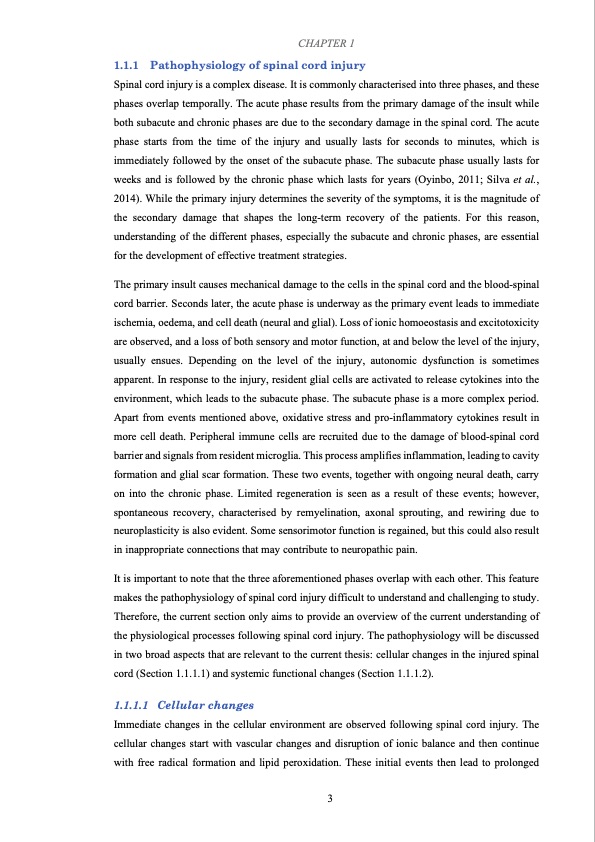
PDF Publication Title:
Text from PDF Page: 017
CHAPTER 1 1.1.1 Pathophysiology of spinal cord injury Spinal cord injury is a complex disease. It is commonly characterised into three phases, and these phases overlap temporally. The acute phase results from the primary damage of the insult while both subacute and chronic phases are due to the secondary damage in the spinal cord. The acute phase starts from the time of the injury and usually lasts for seconds to minutes, which is immediately followed by the onset of the subacute phase. The subacute phase usually lasts for weeks and is followed by the chronic phase which lasts for years (Oyinbo, 2011; Silva et al., 2014). While the primary injury determines the severity of the symptoms, it is the magnitude of the secondary damage that shapes the long-term recovery of the patients. For this reason, understanding of the different phases, especially the subacute and chronic phases, are essential for the development of effective treatment strategies. The primary insult causes mechanical damage to the cells in the spinal cord and the blood-spinal cord barrier. Seconds later, the acute phase is underway as the primary event leads to immediate ischemia, oedema, and cell death (neural and glial). Loss of ionic homoeostasis and excitotoxicity are observed, and a loss of both sensory and motor function, at and below the level of the injury, usually ensues. Depending on the level of the injury, autonomic dysfunction is sometimes apparent. In response to the injury, resident glial cells are activated to release cytokines into the environment, which leads to the subacute phase. The subacute phase is a more complex period. Apart from events mentioned above, oxidative stress and pro-inflammatory cytokines result in more cell death. Peripheral immune cells are recruited due to the damage of blood-spinal cord barrier and signals from resident microglia. This process amplifies inflammation, leading to cavity formation and glial scar formation. These two events, together with ongoing neural death, carry on into the chronic phase. Limited regeneration is seen as a result of these events; however, spontaneous recovery, characterised by remyelination, axonal sprouting, and rewiring due to neuroplasticity is also evident. Some sensorimotor function is regained, but this could also result in inappropriate connections that may contribute to neuropathic pain. It is important to note that the three aforementioned phases overlap with each other. This feature makes the pathophysiology of spinal cord injury difficult to understand and challenging to study. Therefore, the current section only aims to provide an overview of the current understanding of the physiological processes following spinal cord injury. The pathophysiology will be discussed in two broad aspects that are relevant to the current thesis: cellular changes in the injured spinal cord (Section 1.1.1.1) and systemic functional changes (Section 1.1.1.2). 1.1.1.1 Cellular changes Immediate changes in the cellular environment are observed following spinal cord injury. The cellular changes start with vascular changes and disruption of ionic balance and then continue with free radical formation and lipid peroxidation. These initial events then lead to prolonged 3PDF Image | Effects of Red Light Treatment on Spinal Cord Injury

PDF Search Title:
Effects of Red Light Treatment on Spinal Cord InjuryOriginal File Name Searched:
Thesis_Di Hu_final.pdfDIY PDF Search: Google It | Yahoo | Bing
Cruise Ship Reviews | Luxury Resort | Jet | Yacht | and Travel Tech More Info
Cruising Review Topics and Articles More Info
Software based on Filemaker for the travel industry More Info
The Burgenstock Resort: Reviews on CruisingReview website... More Info
Resort Reviews: World Class resorts... More Info
The Riffelalp Resort: Reviews on CruisingReview website... More Info
| CONTACT TEL: 608-238-6001 Email: greg@cruisingreview.com | RSS | AMP |